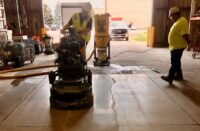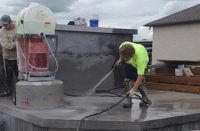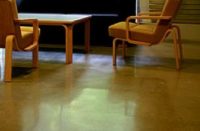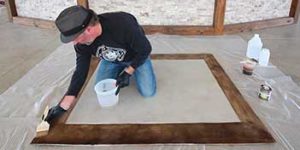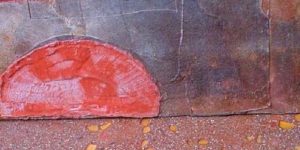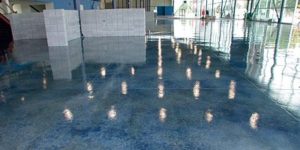The one universal truth about the polished concrete industry is that there is no universal truth. We don’t agree on the definition of polished concrete, what steps are important, or the best way to steer the industry. Still, there are myths and there are accurate perceptions.
So, I’d like to continue to identify some of the basic building blocks of polishing and examine them in terms of “myth” or “accurate perception.”
Full-range cut: To cut or not to cut? What steps are required? In the early days of concrete polishing, it was natural to follow the sequencing established in the natural stone industry, where each step is followed by a pass with a diamond grit half the size of the previous one. You did not skip steps. Period. This was important because the intent in polishing is to create a consistent, uniform scratch pattern when you grind and polish. For the greatest clarity, and the most consistent shine and depth to your reflection, you want to stay with this sequencing, skipping no steps.
But the question isn’t always about clarity or about removing all laitance. So the best advice is to be honest with the customer: 1) For crisp clarity and high polish, don’t skip steps, but 2) if the customer’s budget doesn’t allow for the full sequencing and they’re primarily looking for a clean floor with the benefits of densification, skipping a step with the right diamonds won’t get you in trouble.
Wet versus dry: The debate continues on wet versus dry, and the applicator’s decision is often based on how they were initially taught and how they receive the best results based on their grinder, diamonds and concrete. Most applicators understand that they can achieve a good polish either way, and with many the method is dependent on the manufacturers with whom they are associated. Many applicators combine the two techniques as they grind and polish, feeling that water assists in the cutting with the early metal steps, but that they achieve a better polish at the top end going dry. Be aware that in going dry the shimmer you receive with phenolic resins can just as easily come from resin melted in the surface as from the diamond polish.
Keeping your diamonds and floor clean: Failure to keep the diamonds and floor clean, especially in the grinding stages, can come back to bite you as you move ahead in your sequencing. Even when grinding dry it is imperative that you clean the floor between steps in order to remove fretted diamonds and concrete fines from your floor surface. Water not only helps to clean diamonds and the floor, but also provides you with the ability to identify depressions that you missed or previous scratch patterns that were never successfully removed.
What’s neutral? When talking about cleaning concrete you often hear the term “neutral cleaner.” “Neutral” when discussing the pH scale generally refers to a reading of 7.0 on a scale of 0 to 14, but your definition needs to take into account the pH of the floor being cleaned. A cleaner with a pH of 9.2 to 9.5 in the properly diluted state actually parallels the pH of concrete, so while it is slightly alkaline, it is “neutral” to the concrete. You do not want cleaners that contain sulfates or hydroxides, because they attack concrete, but you do want a slightly alkaline cleaner.
Biased testing results: Testing can either be subjective or objective depending on what results you are trying to achieve. Too often testing in our industry is skewed to deliver results that a particular manufacturer or applicator is seeking. Is testing inherently wrong? No. Can the “skewing” be innocent? Yes. The test areas that are abused the most are also the ones that should be counted on the most to establish performance. Be careful in what you ask for and stand back if you do not understand the individual tests. Use the tests in a uniform, objective way.
Early cuts — ripping the cap: We are all familiar with the idea of the “28-day cure,” but we have all come upon jobs where we get pushed to be on the slab in seven, 10 or 14 days. Early cuts can cause fractures. The calcium hydroxide is formed during curing, and without it you cannot have complete hardening and strengthening of the slab. Often GCs or applicators who want to argue point to early cutting of the slab when installing cementitious terrazzo. What they don’t acknowledge is that this cutting is to promote flatness, that it is done to expose the glass or marble consistently, that a slurry coat is applied to fill all the fissures and fractures created by this early cut, and that the floor is allowed to complete its 28-day cure prior to polishing.
Tire markings: Why is densified concrete so good at resisting tire markings? Consider what happens when a tire marks a floor. Very simply, tire marking on coatings occurs when tire rotation and forklift or truck weight heats the tire rubber and the floor coating. As the tire sheds hot rubber particles under weight, the heated coating absorbs them, and then traps them during the cooling process.
Whiting/acid neutralization: Whenever you apply an acid stain to concrete that will also be densified, you must completely neutralize and remove the acid residue before densifying the slab. You are likely to get whiting from the acid-alkyl reaction between the low-pH acid stain and high-pH concrete. This whiting usually requires grinding to remove it. A variety of products are utilized to neutralize, from ammonia and trisodium phosphate (TSP) to baking soda. Whenever you neutralize with baking soda you must add warm water to ensure that the baking soda goes fully into solution. Allow the neutralizing solution adequate time to dwell and penetrate, or all you will do is neutralize the surface and acids will wick up as the slab dries.
Acid cutting: An acid stain is composed of metallic salts, water and acid, with the acid generally being at a 10 percent dilution. Whenever you are trying to lighten an acid stain it is important to first create a “dilution solution” of water and 10 percent acid. As the acid is there to open the pores to receive the metallic salts, an improperly diluted acid stain will only achieve weakened penetration, resulting in a very blotchy job.
Gloss meter: I’ve previously devoted a column to this topic, so I won’t be too wordy. Simply, make sure that you utilize the gloss meter to document objective improvement in the floor. And remember, every square inch of concrete varies.
